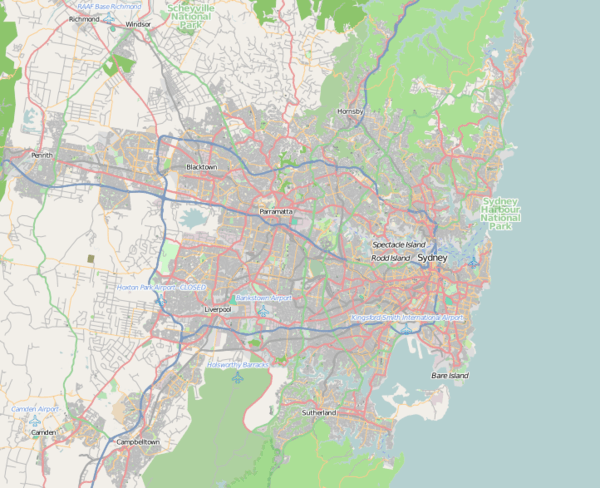Department of Lands building
| Department of Lands building | |
|---|---|
|
Bridge Street façade of the Department of Lands building | |
 Location in Greater Metropolitan Sydney | |
| General information | |
| Type | Government administration |
| Architectural style | Victorian Renaissance Revival |
| Address | 22-33 Bridge Street, Sydney, New South Wales |
| Country | Australia |
| Coordinates | 33°51′50″S 151°12′36″E / 33.863915°S 151.209933°ECoordinates: 33°51′50″S 151°12′36″E / 33.863915°S 151.209933°E |
| Current tenants | NSW Office of Environment & Heritage |
| Construction started | 1876 |
| Estimated completion | 1892 |
| Owner | Government of New South Wales |
| Height | |
| Roof | Copper dome, 17 metres (55 ft) square to octagon |
| Dimensions | |
| Other dimensions | Clock tower with copper 'onion' top |
| Technical details | |
| Structural system | Reinforced concrete slabs |
| Material | Pyrmont sandstone |
| Floor count | 3 |
| Design and construction | |
| Architect |
|
| Architecture firm | Colonial Architect of New South Wales |
| Developer | Government of New South Wales |
| Main contractor |
|
| Designations |
|
| References | |
| [1] | |
The Department of Lands building is a heritage-listed[2] state government administrative building of the Victorian Renaissance Revival architectural style located in Bridge Street in the Sydney central business district of New South Wales, Australia. The large three-storey public building was designed by Colonial Architect James Barnet and built in different stages, with Walter Liberty Vernon and William Edmund Kemp designing various components of the building. The builder was John Young.[1]
The building was initially occupied by the NSW Department of Lands, which has a long association with the public life of New South Wales, especially the rapid expansion of settlement during the later part of the 19th century. The building is currently occupied by the NSW Office of Environment & Heritage.
In the late 1980s, the building was earmarked by the NSW Government as one of the possible sites for conversion into a casino. A permanent conservation order covering the premises was passed by the Heritage Council of New South Wales in order to protect the building from unsympathetic development.[1]
Location
In 1892 when construction of the Lands Department building commenced, the location of the inaugural and temporary Government House was at the junction of what is now known as Bridge and Phillip Streets, a site now occupied by the Museum of Sydney. At that time, Bridge Street ran from George Street to Government House. The Lands Department building was located immediately 'down hill' from Government House and occupied a city block bounded by Bridge, Loftus, Bent and Gresham Streets. The design of the three-storey building, plus basement, provided uninterrupted views from its north-facing verandahs to Port Jackson and Sydney Cove.
For many years the building served as the head office for the highly influential Surveyor General and the Colonial Architect.[1]
Composition style and features
Barnet, who favoured Classical styles in his public building projects, designed the building in the Victorian Renaissance Revival architectural style. It was built between 1876-1892. Dressed Pyrmont sandstone is the dominant material of the façades, with a dome and tower tops made from copper. The four façades of the building are all richly decorated with classical motifs and statuettes and are dissimilar to each other. Barnet’s mix of the orders and their integration into the building is significant. For example, the lowest level of the building is adorned with Doric and Ionic pilasters, whereas Corinthian and Ionic ones are used above. The clock tower has an 'onion' copper dome which was influenced by Sir Henry Parkes’s water carafe.[3]
At the time of its completion, it was the largest of public buildings, boasting the latest in office technology at the time - speaking tubes, pneumatic bells, spiral stairs, and a mosaic of Queen Victoria's coat of arms at the entrance. Barnet designed the building with a plan room with a heavy, fireproof metal door.[4]
Entrances
The main entrance for this building is on Bridge Street. The basement on the Gresham Street side has two entrances, one of which was previously used for horse-drawn carriages.[1]
Niches
Each of the four façades has twelve niches whose sculpted occupants include explorers and legislators who made a major contribution to the opening up and settlement of the nation. Although 48 men were nominated by Barnet as being suitable subjects, most were rejected as being 'hunters or excursionists'. Only 23 statues were commissioned including Hamilton Hume, William Hovell, Major Sir Thomas Mitchell, Gregory Blaxland, William Lawson, William C. Wentworth, George Bass, Matthew Flinders and Sir Joseph Banks.[4] The last statue added was James Meehan in 2010, leaving 24 niches unfilled.[1]
Gallery
 The distinctive 'onion' clock tower
The distinctive 'onion' clock tower_Department_of_Lands_3A.jpg) Niche detail
Niche detail_Dept_of_Lands_3A.jpg) Detail of main entrance
Detail of main entrance- The clock tower at night
See also
References
- 1 2 3 4 5 6 "Lands Department Building". NSW State Heritage Register. Office of Environment & Heritage, Government of New South Wales. 3 November 2006. Retrieved 29 December 2016.
- ↑ Australian Heritage Commission (1981), The Heritage of Australia: the illustrated register of the National Estate, South Melbourne: The Macmillan Company of Australia in association with the Australian Heritage Commission, p. 94, ISBN 978-0-333-33750-9
- ↑ Haskell, John (1997). Sydney Architecture. Sydney: University of New South Wales Press. p. 30.
- 1 2 "Lands Department Bldg". Visit Sydney Australia. Phoenix Group Co. 2015. Retrieved 30 December 2016.
External links
| Wikimedia Commons has media related to Bridge Street, Sydney. |